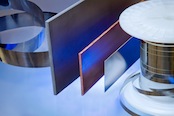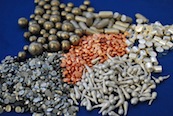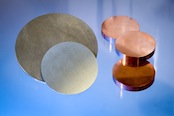Phosphor Type 1152
MATERIAL SAFETY DATA SHEET
I. PRODUCT IDENTIFICATION
Manufacturer/Supplier:
ESPI Metals
1050 Benson Way, Ashland, OR 97520
Toll Free (800) 638-2581 * Fax (541) 488-8313
E-Mail: This email address is being protected from spambots. You need JavaScript enabled to view it.
Product Name: Yttrium Oxysulfide: Europium Activated
Formula: Y2O2S:Eu (Generic)
CAS Number: 68787-83-8
Synonyms: Phosphor Type 1152, Phosphor P-22
II. HAZARDOUS INGREDIENTS
Hazardous Components: Yttrium Oxysulfide
Percent (%): 95
OSHA/PEL: 1 mg(Y)/m3
ACGIH/TLV: 1 mg(Y)/m3
HMIS Ratings:
Health: 1
Flammability: 0
Reactivity: 0
III. PHYSICAL DATA
Boiling Point: N/E
Melting Point: N/E
Specific Gravity: 4.9 g/cc
Solubility in H2O: Insoluble
Appearance and Odor: White or red powder.
IV. FIRE AND EXPLOSION HAZARDS DATA
Flash Point (Method Used): N/A
Autoignition Temperature: N/A
Flammable Limits: Upper: N/A Lower: N/A
Extinguishing Media: No fire hazard. Use extinguishing agents suitable for the surrounding fire.
Special Fire Fighting Procedures: Use a self-contained breathing apparatus to prevent inhalation of dust, mist and/or fumes that may be generated during fire fighting activities.
Unusual Fire & Explosion Hazard: None
V. HEALTH HAZARD INFORMATION
Effects of Exposure:
To the best of our knowledge the chemical, physical and toxicological properties of phosphor type 1134 have not been thoroughly investigated and recorded.
Yttrium is considered a rare earth metal. These metals are moderately to highly toxic. The symptoms of toxicity of the rare earth elements include writhing, ataxia, labored respiration, walking on the toes with arched back and sedation. The rare earth elements exhibit low toxicity by ingestion exposure. However, the intraperitoneal route is highly toxic while the subcutaneous route is poison to moderately toxic. The production of skin and lung granulomas after exposure to them requires extensive protection to prevent such exposure. (Sax, Dangerous Properties of Industrial Materials)
Sulfides show variable toxicity. The alkaline sulfides are similar in action to alkalies. They cause irritation of the skin and are corrosive by ingestion. The heavy metal sulfides are generally insoluble and show little toxic action except through the liberation of hydrogen sulfide. Hydrogen sulfide, if generated, is toxic, a severe irritant and flammable. Effects include conjunctivitis, headache, nausea, dizziness, coughing, pulmonary edema and possibly death
Medical Conditions Generally Aggravated by Exposure: Pre-existing respiratory disorders.
Carcinogenicity: NTP: No IARC: No OSHA: No
EMERGENCY AND FIRST AID PROCEDURES:
INHALATION: Remove to fresh air, keep warm and quiet, give oxygen if breathing is difficult and seek medical attention.
INGESTION: Give 1-2 glasses of milk or water, induce vomiting and seek medical attention. Never induce vomiting or give anything by mouth to an unconscious person.
SKIN: Wash with soap and a large volume of water. Seek medical attention as necessary, especially if irritation develops or persists.
EYES: Flush with copious amounts of water. If irritation persists, seek medical attention.
VI. REACTIVITY DATA
Stability: Stable
Conditions to Avoid: Water/moisture, air.
Incompatibility (Material to Avoid): Acids
Hazardous Decomposition Products: Oxides of sulfur.
Hazardous Polymerization: Will not occur.
VII. SPILL OR LEAK PROCEDURES
Steps to Be Taken in Case Material Is Released or Spilled: Wear appropriate respiratory and protective equipment specified in section VIII. Ventilate area of spill. Clean-up using methods which avoid dust generation such as vacuuming (with appropriate filter to prevent airborne dust levels which exceed the PEL or TLV). Wet dust mop or wet clean-up. If airborne dust is generated, use an appropriate NIOSH approved respirator.
Waste Disposal Method: Dispose of in accordance with all State, Federal and Local regulations.
VIII. SPECIAL PROTECTION INFORMATION
Respiratory Protection: NIOSH approved respirator.
Ventilation: Use local exhaust ventilation which is adequate to limit personal exposure to levels which do not exceed the PEL or TLV. If such equipment is not available use respirators as specified above.
Protective Gloves: Rubber gloves
Eye Protection: Safety glasses.
Other Protective Clothing or Equipment: Protective gear suitable to prevent contamination.
IX. SPECIAL PRECAUTIONS
Precautions to Be Taken in Handling and Storage: Store in a cool, dry area. Store in tightly sealed containers. Wash thoroughly after handling and before eating or smoking and at the end of the work shift. Do not shake clothing or other items to remove dust. Use a vacuum. Avoid dust inhalation and direct skin contact. Do not ingest.
Work Practices: Implement engineering and work practice controls to reduce and maintain concentration of exposure at low levels. Use good housekeeping and sanitation practices. Do not use tobacco or food in work area. Wash thoroughly before eating and smoking. Do not blow dust off clothing or skin with compressed air. Maintain eyewash capable of sustained flushing, safety drench shower and facilities for washing.
TSCA: All components are listed
DOT Regulations:
Hazard Class: None
The above information is believed to be correct, but does not purport to be all inclusive and shall be used only as a guide. ESPI shall not be held liable for any damage resulting from handling or from contact with the above product.
Issued By: S. Dierks
Dated: September 2006

 ALLOYS
ALLOYS 





